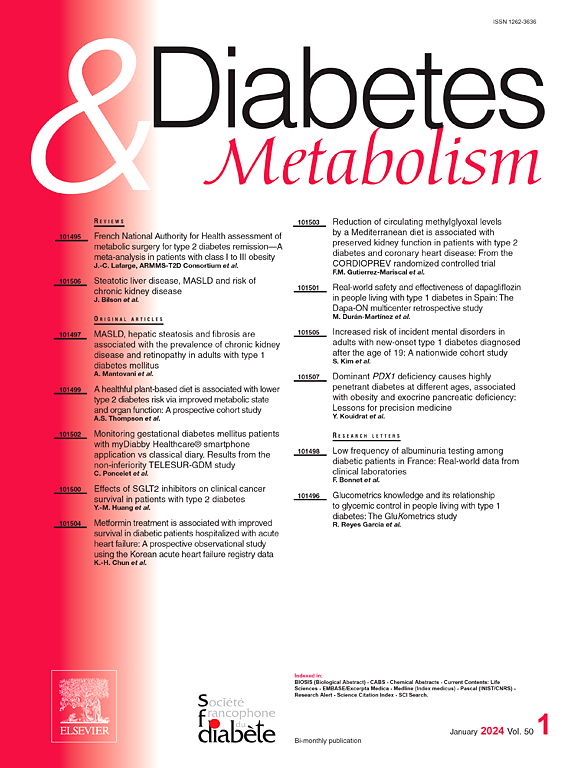老年髋部骨折和2型糖尿病:ne迪斯队列的危险因素分析
IF 4.7
2区 医学
Q1 ENDOCRINOLOGY & METABOLISM
引用次数: 0
摘要
目的:分析2型糖尿病(T2D)与老年人髋部骨折发生率的关系,同时考虑社会经济地位(SES)和其他危险因素(RFs)的影响。方法:数据来自5278名年龄≥65岁的参与者。该研究包括基线和3年后的随访调查。参与者完成了问卷调查、人体测量、血液测试以及身体和认知工具。这项研究是在三个不同社会经济背景的西班牙社区进行的。结果:-基线时,有874例T2D和4,494例对照。髋部骨折患者的身体质量指数(BMI)略高。在BMI、受教育程度、体力活动、骨质疏松、白内障和骨关节炎方面观察到显著差异。在随访调查中,96例新发患者,615例既往T2D患者和2985例对照患者进行比较。髋部骨折患者受教育程度较低,久坐不动,骨质疏松症、白内障和骨关节炎的发病率较高。髋骨骨折患者的Charlson指数更高。骨折发生在城市地区的比例较高。t2dm的发生率在有和没有骨折的个体之间没有差异。结论:t2dm髋部骨折的rf与普通人群相似。骨质疏松、女性和高龄是髋部骨折的独立风险因素。教育水平、社区分配和体育活动之间存在负相关,这可能进一步增加髋部骨折的风险。这些突出表明需要进行研究,以更好地了解T2D和这些RFs在髋部骨折发生率中的作用。本文章由计算机程序翻译,如有差异,请以英文原文为准。
Hip fractures and type 2 diabetes in the elderly: Risk factors analysis of the Nedices cohort
Aim
- To analyze the association between type 2 diabetes (T2D) and the incidence of hip fractures in the elderly, while also considering the influence of socioeconomic status (SES), and other risk factors (RFs).
Methods
- Data were collected from 5278 participants aged ≥ 65 years. The study included a baseline and a follow-up survey 3 years later. Participants completed a questionnaire, anthropometric measurements, blood tests, and physical and cognitive tools. The research was conducted in three Spanish communities with different socioeconomic backgrounds.
Results
- At baseline, there were 874 T2D and 4494 controls. Body mass index (BMI) was slightly higher in individuals with hip fractures. Significant differences were observed in BMI, education level, physical activity, osteoporosis, cataracts, and osteoarthritis. In the follow-up survey, 96 newly, 615 previously T2D, and 2985 controls were compared. Those with hip fractures were associated with lower educational attainment, sedentary life, and higher diagnoses of osteoporosis, cataracts, and osteoarthritis. Charlson index was higher in individuals with hip fractures. A higher proportion of fractures occurred in urban areas. The rate of incidence of T2D between individuals with and without fractures was not different.
Conclusion
- RFs for hip fractures in T2D are similar to those in the general population. Osteoporosis, being female, and advancing age were independent RFs for hip fractures. There was an inverse association between educational level, community allocation, and physical activity which may further contribute to hip fracture risk. These highlights the need for research to better understand the role of T2D and these RFs in hip fracture incidence.
求助全文
通过发布文献求助,成功后即可免费获取论文全文。
去求助
来源期刊

Diabetes & metabolism
医学-内分泌学与代谢
CiteScore
12.00
自引率
4.20%
发文量
86
审稿时长
13 days
期刊介绍:
A high quality scientific journal with an international readership
Official publication of the SFD, Diabetes & Metabolism, publishes high-quality papers by leading teams, forming a close link between hospital and research units. Diabetes & Metabolism is published in English language and is indexed in all major databases with its impact factor constantly progressing.
Diabetes & Metabolism contains original articles, short reports and comprehensive reviews.
 求助内容:
求助内容: 应助结果提醒方式:
应助结果提醒方式:


